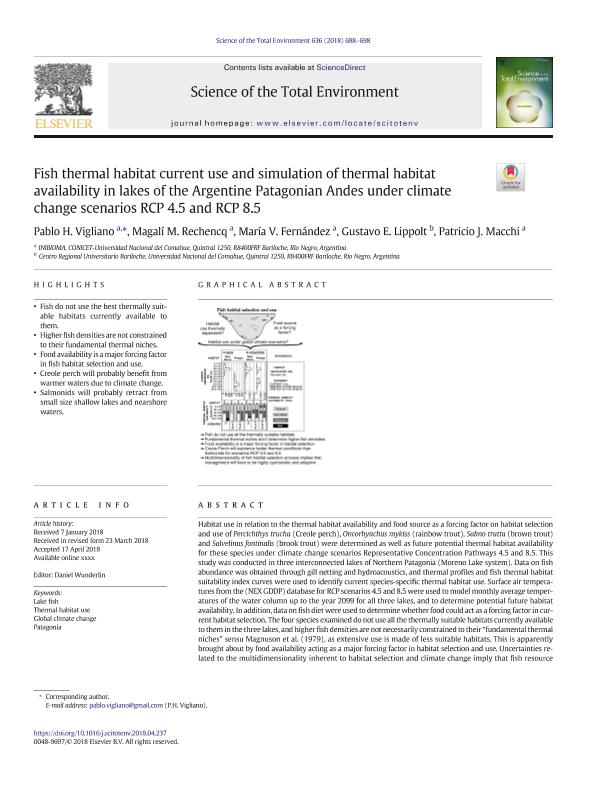Mostrar el registro sencillo del ítem
dc.contributor.author
Vigliano, Pablo Horacio

dc.contributor.author
Rechencq, Magali

dc.contributor.author
Fernández, María Valeria

dc.contributor.author
Lippolt, Gustavo E.
dc.contributor.author
Macchi, Patricio Jorge

dc.date.available
2020-01-14T21:12:36Z
dc.date.issued
2018-09
dc.identifier.citation
Vigliano, Pablo Horacio; Rechencq, Magali; Fernández, María Valeria; Lippolt, Gustavo E.; Macchi, Patricio Jorge; Fish thermal habitat current use and simulation of thermal habitat availability in lakes of the Argentine Patagonian Andes under climate change scenarios RCP 4.5 and RCP 8.5; Elsevier; Science of the Total Environment; 636; 9-2018; 688-698
dc.identifier.issn
0048-9697
dc.identifier.uri
http://hdl.handle.net/11336/94718
dc.description.abstract
Habitat use in relation to the thermal habitat availability and food source as a forcing factor on habitat selection and use of Percichthys trucha (Creole perch), Oncorhynchus mykiss (rainbow trout), Salmo trutta (brown trout) and Salvelinus fontinalis (brook trout) were determined as well as future potential thermal habitat availability for these species under climate change scenarios Representative Concentration Pathways 4.5 and 8.5. This study was conducted in three interconnected lakes of Northern Patagonia (Moreno Lake system). Data on fish abundance was obtained through gill netting and hydroacoustics, and thermal profiles and fish thermal habitat suitability index curves were used to identify current species-specific thermal habitat use. Surface air temperatures from the (NEX GDDP) database for RCP scenarios 4.5 and 8.5 were used to model monthly average temperatures of the water column up to the year 2099 for all three lakes, and to determine potential future habitat availability. In addition, data on fish diet were used to determine whether food could act as a forcing factor in current habitat selection. The four species examined do not use all the thermally suitable habitats currently available to them in the three lakes, and higher fish densities are not necessarily constrained to their “fundamental thermal niches” sensu Magnuson et al. (1979), as extensive use is made of less suitable habitats. This is apparently brought about by food availability acting as a major forcing factor in habitat selection and use. Uncertainties related to the multidimensionality inherent to habitat selection and climate change imply that fish resource management in Patagonia will not be feasible through traditional incremental policies and strategic adjustments based on short-term predictions, but will have to become highly opportunistic and adaptive.
dc.format
application/pdf
dc.language.iso
eng
dc.publisher
Elsevier

dc.rights
info:eu-repo/semantics/openAccess
dc.rights.uri
https://creativecommons.org/licenses/by-nc-sa/2.5/ar/
dc.subject
GLOBAL CLIMATE CHANGE
dc.subject
LAKE FISH
dc.subject
PATAGONIA
dc.subject
THERMAL HABITAT USE
dc.subject.classification
Biología

dc.subject.classification
Ciencias Biológicas

dc.subject.classification
CIENCIAS NATURALES Y EXACTAS

dc.title
Fish thermal habitat current use and simulation of thermal habitat availability in lakes of the Argentine Patagonian Andes under climate change scenarios RCP 4.5 and RCP 8.5
dc.type
info:eu-repo/semantics/article
dc.type
info:ar-repo/semantics/artículo
dc.type
info:eu-repo/semantics/publishedVersion
dc.date.updated
2019-10-10T13:57:47Z
dc.journal.volume
636
dc.journal.pagination
688-698
dc.journal.pais
Países Bajos

dc.journal.ciudad
Amsterdam
dc.description.fil
Fil: Vigliano, Pablo Horacio. Consejo Nacional de Investigaciones Científicas y Técnicas. Centro Científico Tecnológico Conicet - Patagonia Norte. Instituto de Investigaciones en Biodiversidad y Medioambiente. Universidad Nacional del Comahue. Centro Regional Universidad Bariloche. Instituto de Investigaciones en Biodiversidad y Medioambiente; Argentina
dc.description.fil
Fil: Rechencq, Magali. Consejo Nacional de Investigaciones Científicas y Técnicas. Centro Científico Tecnológico Conicet - Patagonia Norte. Instituto de Investigaciones en Biodiversidad y Medioambiente. Universidad Nacional del Comahue. Centro Regional Universidad Bariloche. Instituto de Investigaciones en Biodiversidad y Medioambiente; Argentina
dc.description.fil
Fil: Fernández, María Valeria. Consejo Nacional de Investigaciones Científicas y Técnicas. Centro Científico Tecnológico Conicet - Patagonia Norte. Instituto de Investigaciones en Biodiversidad y Medioambiente. Universidad Nacional del Comahue. Centro Regional Universidad Bariloche. Instituto de Investigaciones en Biodiversidad y Medioambiente; Argentina
dc.description.fil
Fil: Lippolt, Gustavo E.. Universidad Nacional del Comahue. Centro Regional Universitario Bariloche. Grupo de Evaluación y Manejo de Recursos Ícticos; Argentina
dc.description.fil
Fil: Macchi, Patricio Jorge. Consejo Nacional de Investigaciones Científicas y Técnicas. Centro Científico Tecnológico Conicet - Patagonia Norte. Instituto de Investigaciones en Biodiversidad y Medioambiente. Universidad Nacional del Comahue. Centro Regional Universidad Bariloche. Instituto de Investigaciones en Biodiversidad y Medioambiente; Argentina
dc.journal.title
Science of the Total Environment

dc.relation.alternativeid
info:eu-repo/semantics/altIdentifier/url/https://www.sciencedirect.com/science/article/pii/S0048969718314141
dc.relation.alternativeid
info:eu-repo/semantics/altIdentifier/doi/http://dx.doi.org/10.1016/j.scitotenv.2018.04.237
Archivos asociados
